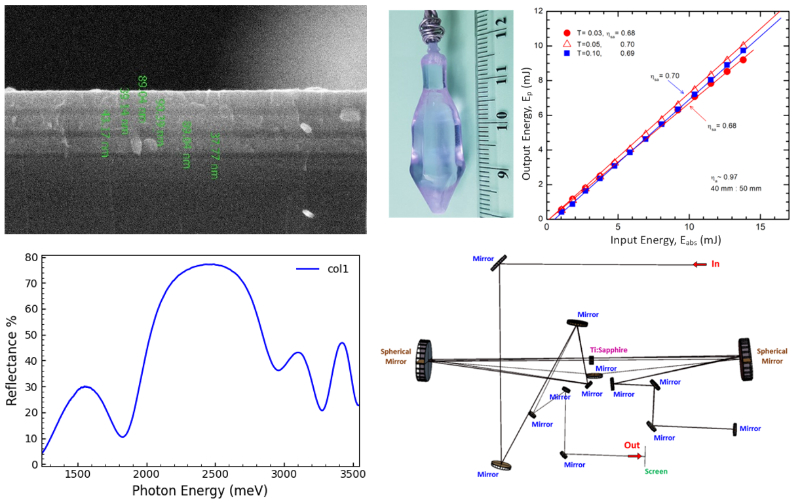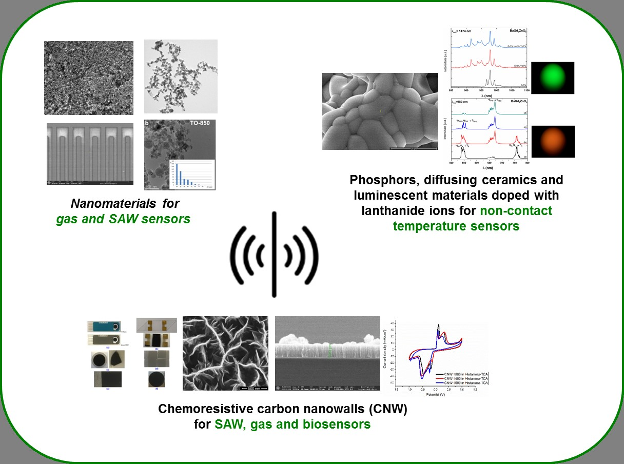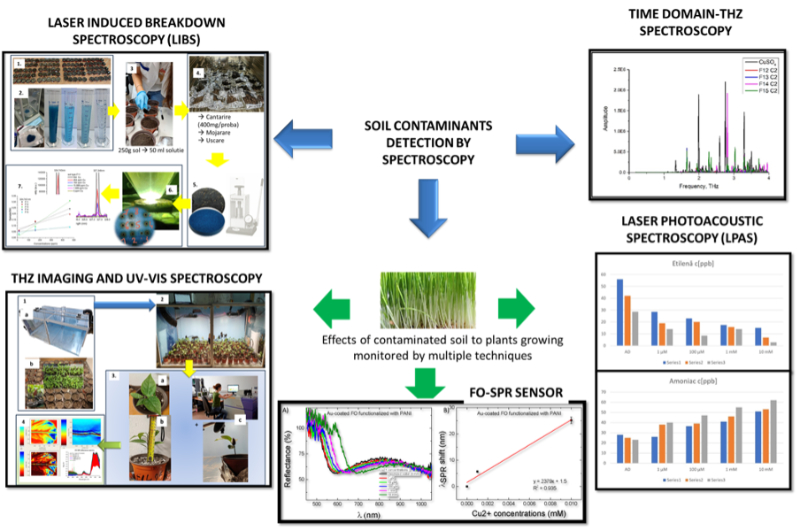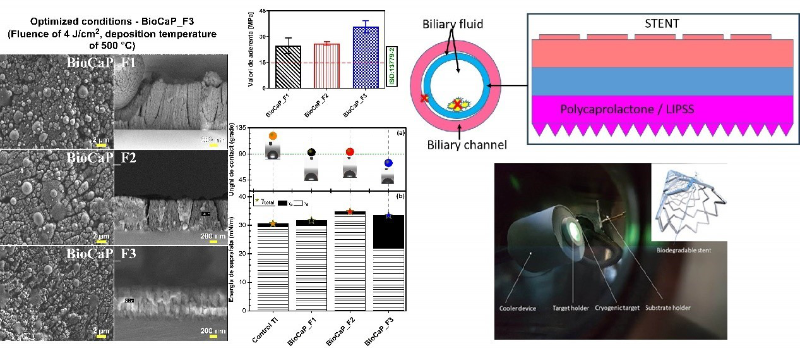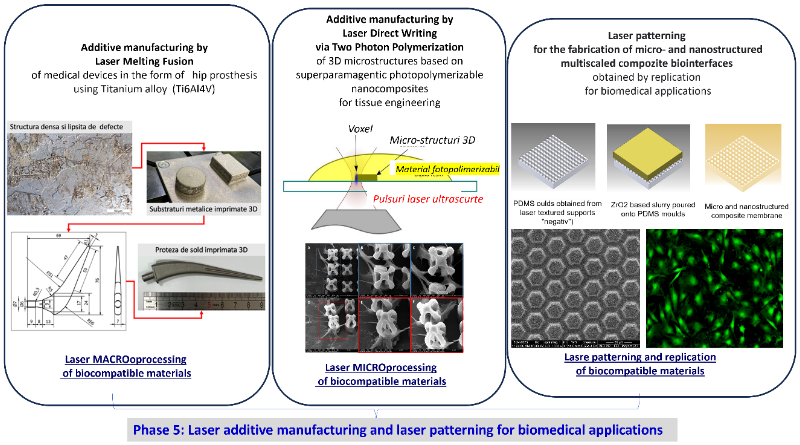
Schema de realizare a proiectului 23 03 01 - Anul 2023 - Etapa I
Contractul nr.: 30N/12.01.2023
Titlu: "Dezvoltarea de soluții inovatoare și tehnologii de fabricație avansată cu laseri, plasmă și radiații pentru rezolvarea problemelor societale"
Faza 1: "Dezvoltare de subansamble și componente pentru un sistem laser cu pulsuri sub-picosecunde"
Responsabil fază: Dr. Marian ZAMFIRESCU
Termen de încheiere a fazei: 12.05.2023
Abstract:
The main objective of this phase of project was the study of optical configurations and optical and electronic subassemblies of a laser amplifier with sub-picosecond pulses, as well as the realization of some components for the pump laser (laser active medium, laser mirrors) that will be part of the configuration final laser system. Nd:LaxGdyYzSc4-x-y-z(BO3)4 - type laser crystals with incongruent melting and efficient laser emission at 1.06 µm were grown for the first time by the Czochralski method. Configurations of Bragg dielectric structures were designed for the realization of laser mirrors, SiO2, TiO2 and HfO2 thin films deposited by PLD, TVA and magnetron sputtering techniques were obtained and characterized, and the optical parameters of the deposited films were determined. A series of numerical studies based on the finite difference method (FDTD) were developed to determine the optimal laser beam propagation media to induce a temporal stretching of the laser pulse in the range of 0.5 - 1 ps. Also, a series of raytracing models were developed for the design of an optimal scheme of a laser amplifier in order to obtain a maximum amplification efficiency according to the current requirements in the field of experiments with ultra-short pulse lasers. This objective represents an intermediate step in the realization of a laser source for advanced additive and subtractive manufacturing of devices for emerging technologies.
Abstract grafic:
Faza 2: "Sinteza și caracterizarea materialelor active utilizate în senzoristică si detecție"
Responsabil fază: Dr. Gabriela CRĂCIUN
Termen de încheiere a fazei: 15.07.2023
Abstract:
In the present stage, the synthesis and characterization of some materials used in sensors and detection by methods with lasers, plasma and radiation was carried out. Oxidized nanopowders with low carbon content were obtained and characterized by the laser pyrolysis technique, phosphors (SrLaGaO4, Ca3Ta2Ga3O12), diffusing ceramics and luminescent materials doped with lanthanide ions (Nd3+, Er3+, Ho3+, Yb3+), carbon nanowalls (CNW) simple or functionalized by plasma techniques and nanoparticles with or without magnetic properties (nAg, nNi) by irradiation with high-energy accelerated electrons.
For the field of gas sensors, oxide nanopowders were synthesized using isopropanol and ethene as sensitizers. The use of isopropanol in the form of vapors led to a decrease in the size of the SnO2-x crystals by 23% compared to the process in which ethene was used. SnxFeyOz nanopowders of 4.5 nm with good crystallinity were also synthesized, the crystal size varying between 3 and 10 nm. For the field of sensors with surface acoustic waves (SAW), TiO2 nanoparticles were synthesized by the laser pyrolysis method from TiCl4 vapors in air and in the presence of ethylene, at different working pressures, the average size of the particles being estimated in the range of 15 – 22 nm.
Also, ceramic phosphors Er:CaSc2O4 (by sol-gel method), RE3+:CTGG and RE3+:SrLaGaO4 (by solid phase reaction) were obtained. Three host matrices (Y2O3, CaSc2O4 and BaGd2ZnO5) prepared by the solid phase reaction method and doped with three lanthanide ion systems (Er3+-Yb3+, Ho3+-Yb3+ and Er3+-Ho3+-Yb3+) were selected to obtain materials with pure crystallinity that have confirmed emissions in the 500-800 nm range. The structural and morphological analyzes indicated favorable properties of these materials for applications as non-contact temperature sensors.
Simple or functionalized carbon nanowalls (CNW) were synthesized by RF plasma techniques, on several types of supports in order to obtain self-supporting nanostructures. New effects of CNW were identified and tested, with applications in the field of SAW sensors, chemoresistive gas sensors and biosensors.
By optimizing the irradiation process by applying an experimental design of Central Composite Design (circumscribed) - Response Surface Methodology (CCD-RSM) type with 20 positions, led to the obtaining of silver nanoparticles (nAg) with a desirability of 0.810 at an irradiation dose of 17.6 kGy. Nickel nanoparticles (nNi) with magnetic properties were obtained at an irradiation dose of 300 kGy, their size varying between 20 and 70 nm.
Abstract grafic:
Faza 3: "Dezvoltarea de metode și protocoale de detecție cu aplicații în agricultura inteligentă"
Responsabil fază: Dr. Gabriel SOCOL
Termen de încheiere a fazei: 13.10.2023
Abstract:
Soil contamination with heavy metals is a major environmental pollution concern, negatively impacting plant growth, food quality, and animal and population health. To accomplish the objectives of this phase, the effort was focused on the effect of copper, a metal contained in pesticides commonly used in agriculture, on plant and soil development.
Thus, the effects of contaminated soil on plants grown in this environment were investigated. To identify copper concentrations in soil samples, Laser Breakdown Induced Spectroscopy and Time Domain Spectroscopy techniques in the THz domain were used, developing two protocols for soil contaminant detection. A growth chamber with controlled environmental parameters was developed and used to study 125 Asimina Triloba plants grown in contaminated soil samples. Lighting, temperature, and soil moisture conditions were kept constant, monitoring the effects of copper on these plants using UV-VIS spectroscopy and THz imaging. Using these two complementary techniques, a specific protocol was developed for monitoring the effects induced by contaminated soil samples on plants.
In parallel, a protocol for the controlled germination of common wheat seeds was developed and the concentrations of ethylene and ammonia in the respiration of wheat germs (Triticum aestivum) were determined using the laser photoacoustic spectroscopy technique. The contamination was carried out in a controlled manner with CuSO4 solution at molar concentrations of 1 µM, 100 µM, 1 mM, and 10 mM. In parallel, the remedial effect of hydrogel on common wheat germs germinated in soil mixed with hydrogel and two types of nutrients were studied. The same spectroscopy technology was applied to evaluate the influence of heavy metal contaminants on the germination, rooting, growth, and twining of common wheat seeds in soil and hydrogel, thus observing a bioremediation effect on common wheat seedlings.
In addition, two protocols were developed for i) determining the sensitivity of the gold-coated FO-SPR sensor, using sucrose dilutions with a known refractive index and ii) for the reflection-based FO-SPR sensor coated with gold functionalized with PANI, which can detect Cu2+ from deionized water with a sensitivity of 2379 nm/mM and a LOD of 0.35 µM.
This research has contributed to the understanding of the impact of heavy metal contamination on the environment and provided effective detection methods.
Abstract grafic:
Faza 4: "Procesarea cu laseri, plasma si radiatii a structurilor de biomateriale implantabile si pansamente Incarcate cu medicamente chimioterapeutice"
Responsabil fază: Liviu-Marian DUTA, Alexandra PALLA-PAPAVLU
Termen de încheiere a fazei: 08.12.2023
Abstract:
Currently, there is a substantial demand for the production of medical devices intended for applications in regenerative medicine, which aligns well with the advancement of personalized medicine. Within this context, the technology behind biliary stents emerges as a crucial element contributing to the achievement of successful liver transplantation procedures and facilitating rapid patient recovery. Although there are currently numerous options available for biliary stents in terms of materials, designs, and biological functions, these stents still have some drawbacks. Herein, we report on the manufacture of a new design of polycaprolactone (PCL)-based biliary stent device, completely resorbable, intended primarily to support bile duct functions in the post-liver transplant period. We present the results of a study investigating the effects of centrifugation time and speed on the morphological characteristics of PCL thin films produced by spin coating. Lastly, laser-induced periodic surface structures were obtained in the PCL free-standing membrane layers by irradiation with linearly polarized radiation.
The GIXRD diffractograms of BioCaP thin films have evidenced the presence of a single hexagonale HA phase only. It has also been observed that the crystallinity degree of the synthesized structures was influenced by the deposition parameters. FTIR spectra have demonstrated the existence of phosphate bands, specific to a well-crystallized HA structure. This result agreed well with the GIXRD findings. SEM results demonstrated the synthesis of surfaces with a rough and irregular morphology, made of spherical or even ovoidal formations (“particulates”), with different dimensions. Cross-sectional SEM images have shown in all cases the synthesis of uniform coatings, with a columnar-type growth. To the difference of control Ti, for which a hydrophobic behaviour was evidenced, for the BioCaP thin films a hydrophilic behavior was observed. The pull-out adherence tests indicated values superior to the ones imposed by the international standards (i.e., >15 MPa).
We obtained two types of functionalized composite biomaterials: PVP ciclopirox / caspofungin acetate. The nanomaterials were assembled as thin films using the matrix-assisted pulsed laser evaporation (MAPLE) method, on silicon substrates and optical glass. Thin films deposited by MAPLE were characterized by AFM and FTIR.
Abstract grafic:
Faza 4: "Procesarea cu laseri, plasma si radiatii a structurilor de biomateriale implantabile si pansamente Incarcate cu medicamente chimioterapeutice"
Responsabil fază: Irina PAUN, Andrei POPESCU
Termen de încheiere a fazei: 08.12.2023
Abstract:
Phase 5 of the project focused on additive laser manufacturing and laser texturing of structures from biocompatible materials.To fulfill this objective, 3 activities were planned and carried out, all of them having direct applications in the biomedical field. The first activity consiting in additive laser manufacturing by Selective Laser Melting method resulted in medical substrates and devices such as hip prostheses starting from a basic material in the form of spherical particles of grade 5 Ti alloy (Ti6Al4V) with diameters between 20-63 μm. To obtain dense structures, without internal defects, the main processing parameters were: 200 W laser power and processing speed of 2 m/s, used on a layer with a thickness of 20 μm. A Widmanstattentype metallographic structure was identified, with compact hexagonal α phase dendrites grown in two perpendicular directions in a volume-centered cubic β phase. These results will be scaled-up for use in medical engineering applications, more precisely for a wide range of personalized implants. The shape and dimensions of the individualized products will be obtained using 3D X-ray scanning tools (tomography). Another activity consisted in the development of a protocol of additive laser manufacturing by direct laser writing via 2 photon polymerization of 3D microstructures with biomimetic architectures, based on biocompatible polymers, for applications in bone tissue engineering.The motivation for this study was based on the fact that, currently, the manipulation of biological materials at cellular level is a hot topic for biomedical applications. Within this activity, structures in the shape of micro-containers were fabricated using direct laser writing by two-photon polymerization of a composite material based on biocompatible photopolymer and superparamagnetic nanoparticles. The structures were structurally characterized and tested in osteoblast-like cell cultures. It was found that the structures that were seeded with cells and then exposed to static magnetic fields of 1.3 T were about 5 times more efficient in terms of cell capture efficiency, as compared to similar structures that were not stimulated in static magnetic field, demonstrating their potential for engineering bone tissue. In agreement with the previous 2 activities, the third activity carried out within Phase 5 concerned the field of biomedicine, in particular the development of innovative laser assisted technologies to improve the effectiveness of implantable devices. This activity explored the development of an experimental model for excimer laser micromachining, by mask projection, and replication, of microstructured surfaces (PLGA, chitosan, PCL, Zirconia), which were tested and validated in vitro in cell cultures and for which a preliminary biological response was obtained. This approach opened new perspectives for the development of personalized implantable devices with significant potential for integration and improved biological compatibility, contributing to the progress of biomedical applications.
Abstract grafic:

